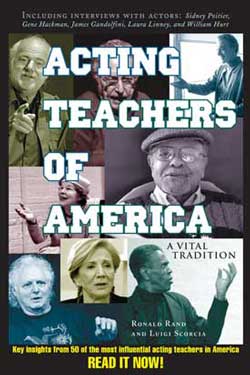Ancient Voices
Contemporary Contexts Forum at the Kanatsiohareke Mohawk Community
This past fall I received the singular privilege of being invited to attend the Ancient Voices-Contemporary Contexts Forum sponsored by the American Indian Institute at the Kanatsiohareke Mohawk Community in upstate New York.
I learned the objective of the Ancient Voices - Contemporary Contexts Forums is to fulfill a 2005 Elders Circle mandate: "get the Elder voice out" and get dialogue started across cultures. The essential elements of the Elders' message include: “We are destroying the earth and the life on it.” “We are killing each other. War and genocide are rampant in many parts of the world because of race, ethnicity, religion and greed. The same factors, along with drugs and alcohol, are at work in more subtle ways throughout the world.” “The indigenous voice is the only one that takes a holistic view of both environmental and social destruction. The indigenous voice is ancient and proven. It is a spiritual voice unencumbered by religious dogma. It is not parochial or selfish, and can be a saving factor in meeting the issues that threaten the world.”
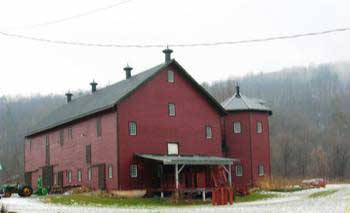 Mohawk Community
Mohawk Community
Since 1996 Ancient Voices-Contemporary Contexts Forums have brought many traditional grassroots spiritual leaders of Indigenous nations of North America together to share their cultural and spiritual wisdom with non-Native people. At the Ancient Voices Forums it is an opportunity to come together to explore the common concerns about the human condition in modern times, to seek ways of living within the natural capacities of the earth, and to recognize what the future holds for our children, and explore alternatives.
As I traveled to the Ancient Voices-Contemporary Contexts Forum, I thought back to my days as a youth growing up in South Florida when it was exciting for me to visit the Seminole Indians at Miccosukee Village along the Tamiami Trail in South Florida. I had also never forgotten seeing the Cherokee outdoor pageant near Gatlinburg called “Unto These Hills” depicting the Trail of Tears of the Cherokee People and the hardships they endured being forced to leave their land. Of course, I had seen countless films and television shows depicting Native American Indians, including “Dances With Wolves” and “Jeremiah Johnson,” but only a very few films ever approach anything resembling the richness of these People with the authenticity necessary to share the beauty of their history. I had also read many books, always with a keen interest to understand how throughout history this country could so mistreat and abuse those who were here even before we approached these shores.
This would be the first time in my life I would begin to understand the rich heritage and history of the Mohawk People and the Iroquois Confederacy.

Passing rolling green hills and plush meadows in the Mohawk Valley, fields of corn stretched up to meet the glistening sun as the Mohawk River flowed nearby through the surrounding mountains. Nearby is the town of Fonda, New York founded by merchant, Jelles Fonda who had run a trading post, and yes, Henry Fonda, Jane Fonda and Peter Fonda are his descendants.
Arriving at Kanatsiohareke Mohawk Community, before me stood what had been referred to as “Montgomery Manor,” a very large structure of many floors and rooms, with various additions foisted upon the main building. With a farm attached, it had, at one time, even served as a home for the aged, poor, and indigent for a hundred years until it was finally boarded up by the county. In 1993, Montgomery Manor was put up for auction and through an amazing quirk of fate was purchased by descendants of the a family which had owned much of the land during the Revolutionary War which had been the site of many Mohawk Bear Clan villages. Prior to that, George Washington had promised the Mohawks that they would keep their lands forever. But after the war, he broke that promise and ordered the destruction of their villages and most Mohawks left the Valley, taking with them a prophesy that said someday they would return to their ancestral homeland.
When Mohawk elder and spiritual leader, Tom Sakokwenionkwas Porter, along with a small group of family and friends chose to leave Canada and return to the Mohawk Valley, after the auction, they were presented with the land to rebuild Kanatsiohareke by descendants from the very same family from over two hundred years ago. Such an amazing and blessed thing to occur!
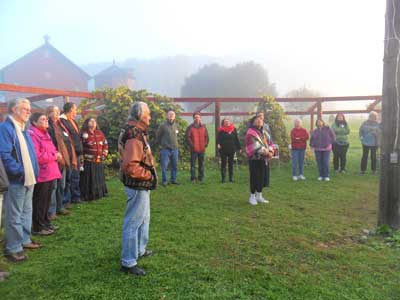
In 1993, Kanatsiohareke, pronounced “Ga –na-jo-ha–lay-gay” was re-established as a Mohawk community, and today there is a working farm with a craft store, a Bed and Breakfast, a Conference Room, and residential apartments.
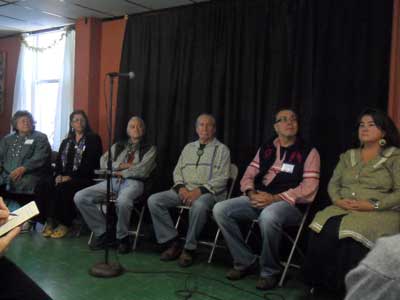
On the first day of the Ancient Voices - Contemporary Contexts Forum, everyone joined in a circle around a burning fire at dawn, which was kept burning during the entire three days we met by those appointed as “fire-keepers.” As they kept the fire going, they would say prayers to protect us. I learned there had to be two “fire-keepers” at all times. Each morning a different chief would chant a prayer of welcoming the new day full of thankfulness to the slow pounding of a drum beat. The sky became light with the sun of the new dawn as the air became filled with the beautiful chirping of the awakening birds and the voice of a Chief thanking the new day for arriving.
Tom Porter
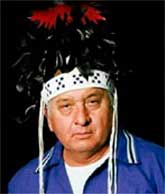 In the main meeting room Tom Porter welcomed everyone in both Mohawk and English. In Sakokwenionk, his name means “The One Who Wins.” He has been the founder, spokesperson and spiritual leader of this Mohawk Community since 1993, and a member of the Bear Clan of the Mohawk Nation at Akwesasne. (Akwesasne, also known as the St. Regis Mohawk Reservation, straddles the New York State/Canadian border near Massena, New York.) Mr. Porter is married to Alice Joe Porter who is Choctaw, and they have six children. He held the position of sub-chief for the Tehanakarine Chieftainship title, one of the nine chief titles of the Mohawk Nation, for 21 years. Chiefs are considered to be spiritual as well as political leaders. Some of the duties of this position include officiating at marriage ceremonies, death ceremonies and numerous other traditional ceremonies held throughout the year. Mr. Porter was the director of and, a teacher at the Akwesasne Freedom School and taught at the Kahnawake Survival School. The purpose of both schools is to teach all of the usual subject matter, but within a traditional Mohawk worldview and with emphasis on keeping the Mohawk language alive and vital. It is said that with the loss of language, there also is the loss of at least 50% of a people’s culture and identity. He worked as Secretary for the Mohawk Nation Council of Chiefs for 8 years and as interpreter for 11 years, and organized the “White Roots of Peace,” a traveling multi-media communications group designed to revitalize Native traditions and beliefs in North America. Currently, Mr. Porter works as the Native American consultant for the New York State Penitentiary System and as Chaplain for all of the Native inmates in the New York State Penal System, conferring with them, teaching and helping them conduct traditional ceremonies. He is also the author of several books including Ohen:ton Karihwatehkwen (The Thanksgiving Address) and Grandma Said.
In the main meeting room Tom Porter welcomed everyone in both Mohawk and English. In Sakokwenionk, his name means “The One Who Wins.” He has been the founder, spokesperson and spiritual leader of this Mohawk Community since 1993, and a member of the Bear Clan of the Mohawk Nation at Akwesasne. (Akwesasne, also known as the St. Regis Mohawk Reservation, straddles the New York State/Canadian border near Massena, New York.) Mr. Porter is married to Alice Joe Porter who is Choctaw, and they have six children. He held the position of sub-chief for the Tehanakarine Chieftainship title, one of the nine chief titles of the Mohawk Nation, for 21 years. Chiefs are considered to be spiritual as well as political leaders. Some of the duties of this position include officiating at marriage ceremonies, death ceremonies and numerous other traditional ceremonies held throughout the year. Mr. Porter was the director of and, a teacher at the Akwesasne Freedom School and taught at the Kahnawake Survival School. The purpose of both schools is to teach all of the usual subject matter, but within a traditional Mohawk worldview and with emphasis on keeping the Mohawk language alive and vital. It is said that with the loss of language, there also is the loss of at least 50% of a people’s culture and identity. He worked as Secretary for the Mohawk Nation Council of Chiefs for 8 years and as interpreter for 11 years, and organized the “White Roots of Peace,” a traveling multi-media communications group designed to revitalize Native traditions and beliefs in North America. Currently, Mr. Porter works as the Native American consultant for the New York State Penitentiary System and as Chaplain for all of the Native inmates in the New York State Penal System, conferring with them, teaching and helping them conduct traditional ceremonies. He is also the author of several books including Ohen:ton Karihwatehkwen (The Thanksgiving Address) and Grandma Said.
Mr. Porter explained why he chose to use the language of his People because it identifies who he is and that for so many years, their very language had been taken away from his People, and they were not allowed to practice their customs and rituals. He then shared with us how the Mohawk People treat nature and animals with such a deep respect, and how necessary it is to thank the Creator for everything around us and to never take anything for granted, He would end each thanking prayer with “And our mind is agreed –.Tow.” And we would repeat: “Tow.” He related many things he learned from his elders and chiefs and explained “we always say “yesterday it happened,” even though it may be in ancient times, and told us that Kanatsiohareke is now a place of cultural revitalization and spiritual and linguistic renewal. When he came here, he wondered: “How would it be possible to retain and revitalize our language? What can be done?” So Kanatsiohareke began offering Mohawk Language immersion classes, as well as hosting classes, lectures, workshops and conferences relating to Haudenosaunee culture.“
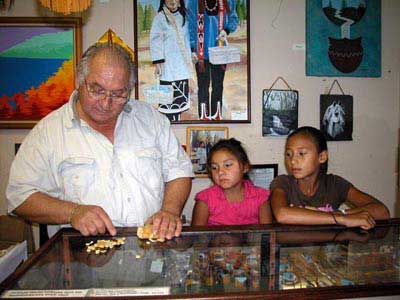
He explained to us Kanatsiohareke means “The Place of The Clean Pot,” “The Place of the Pot That Washes Itself,” or “The Place of the Hanging Pot.” It refers to a spot in Canajoharie Creek where the action of the water has carved perfectly round holes into the stream bed. Long ago, the Mohawks noticed that when the water ran downstream and into those holes, the water swirled and churned around making it look like the water was scrubbing the inside of the potholes.
“The name means a new beginning based on our ancient traditions and teachings. Our logo is of a cooking pot and an Iroqouis man holding a headdress and the arrangement of the three feathers standing up. There is also the Mohawk River, and the rising sun. “
He went on to share about his experiences as a youth. “We had no electricity. I was ten growing up on the reservation. The priest told us he was God’s right-hand man. We believed him. It put fear into us. We didn’t want to go to hell. I went to a government school. We were forced to learn about religion. I went with my cousins. But I never believed what I heard. I would look at the pictures in the big book but none of them looked like my uncles. I thought God was supposed to be kind and would punish by sending us to hell. I became a leader so terror and fear doesn’t become a part of our life. There have been many challenges. Today kids are reclaiming their heritage. I didn’t even know what was an Indian until I was sent to school and learned English. My grandmother didn’t want me to go. I thought everyone talked Mohawk. I didn’t know anyone spoke other languages. When I was six, members of the Hopis came to our longhouse and they had to have interpreters. They were smaller and spoke in a different language. I started to notice Indians were different. When I learned to be a carpenter, I was asked: “What clan are you?” I slowly began to learn who I was.”
Louise McDonald
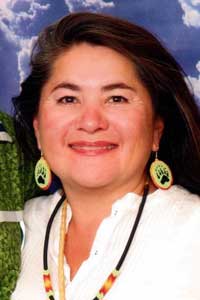 One of the youngest clan mothers of the Bear Clan, Louise McDonald spoke next, relating how important it is to recover and restore cultural practices. A few of the things she shared with us: “As a clan mother I have a forward vision because of the assaults of colonization on indigenous women.”
One of the youngest clan mothers of the Bear Clan, Louise McDonald spoke next, relating how important it is to recover and restore cultural practices. A few of the things she shared with us: “As a clan mother I have a forward vision because of the assaults of colonization on indigenous women.”
“There is a shift coming in our consciousness. In the Long House, I have to ask permission to speak. So what is the message when women are not allowed to speak. I have to ask myself what will it take for me to be a model to move a nation forward, to rebuild a culture and for women to move forward.”
“It is time for women to rise. Through it we can heal each other and return to a place of well-ness.
The following day we were addressed by Oren R. Lyons, Jr, Faithkeeper of the Turtle Clan of the Onodaga and Seneca Nations of the Iroquois Confederacy. A leading advocate of indigenous rights, was a leader in the Trail of Broken Treaties, a caravan to Washington, D.C. to convince the Bureau of Indian Affairs to honor its treaties with Native American tribes. He had helped create the Traditional Circle of Indian Elders and Youth and was also was part of the Haudenosaunee delegation to the first World Conference on Racism. For over fourteen years he has taken part in the meetings in Geneva of Indigenous Peoples of the Human Rights Commission of the UN, helping to establish the Working Group on Indigenous Populations, and is a principal figure in the Traditional Circle of Indian Elders.
Oren Lyons
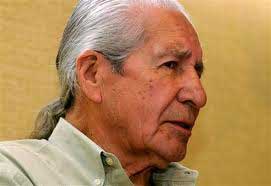 He began by saying: “Everyone is searching today. There’s an empty feeling going on out there. People are wondering where to go and what to do. Time moves on. There are ten billion people on the planet that need food, shelter, water… We can’t control nature, its nature. Hopefully we can do something about it with our knowledge. There is a super ignorance out there. The ice is melting and it doesn’t care what we say or think. The earth does what it does. Our people understand our relationship between ourselves and the earth. So how do we survive? The Indians are still here. But most of our history is not told. I’m a history professor in Buffalo and I ask myself: “Why don’t people know about history? You can’t take land from a good guy. That’s why icons are out there – “cowboys and Indians.” We all did that, even on the reservations. No one wanted to be an Indian. It’s time to ask: “Why are we here?” The Onodagas are 4,000 years old and we’re still here. Mohawks have been a long time. When we talk about what is real – fire is real, a sunrise, the ground you’re standing on. This morning there was a sunrise ceremony – that’s real.
He began by saying: “Everyone is searching today. There’s an empty feeling going on out there. People are wondering where to go and what to do. Time moves on. There are ten billion people on the planet that need food, shelter, water… We can’t control nature, its nature. Hopefully we can do something about it with our knowledge. There is a super ignorance out there. The ice is melting and it doesn’t care what we say or think. The earth does what it does. Our people understand our relationship between ourselves and the earth. So how do we survive? The Indians are still here. But most of our history is not told. I’m a history professor in Buffalo and I ask myself: “Why don’t people know about history? You can’t take land from a good guy. That’s why icons are out there – “cowboys and Indians.” We all did that, even on the reservations. No one wanted to be an Indian. It’s time to ask: “Why are we here?” The Onodagas are 4,000 years old and we’re still here. Mohawks have been a long time. When we talk about what is real – fire is real, a sunrise, the ground you’re standing on. This morning there was a sunrise ceremony – that’s real.
He went on to share the story of The Peacekeeper, a spiritual prophet who led them into peace-keeping, and about the creation of the Iroquois Confederacy and how it came to be. He showed us a wintock with notches on it representing all the tribes which came together around the 16th century to form the Confederacy, (Often known as the Five Nations, it was composed of the Mohawk, Oneida, Onondaga, Cayuga, and Seneca nations. In 1722, the Tuscarora nation joined the League).
“It was a dark, violent time. Wars took place in every village among the Five Nations. At this time the Creator sent a messenger of peace. His actual name is sacred. We never use it. He was called the "Peacemaker." His mission was to restore love, peace and harmony back to the people. To do this, he proposed a set of laws which all people could live in peace and unity, guided by principles called the Great Law of Peace. The Peacemaker was born a Huron to a young virgin woman who hadn’t gone through her puberty rites when she became pregnant. Her mother was worried what the village would say, so she hid her away until she gave birth. She convinced her daughter they had to kill the baby. The grandmother tried three times but she failed. She realized he must be someone with special powers so she raised him carefully. When he reached manhood, he realized it was time for him to leave on his mission. He built a canoe. The canoe was made of white stone. When it was time for him to set out on his journey, he put it on the water but it didn’t sink. All the village came. They were amazed. They couldn’t believe it. They had never seen a stone float before. Once he took off, they thought it would sink. But it didn’t. The canoe disappeared into the distance.
He came to a woman. Her name was Jikonsahseh. She was the first person to embrace the Peacemaker. Her dwelling was sort of a neutral zone for anyone passing through. War parties would leave their weapons outside. She’d feed everyone and offer them a resting place. When The Peacemaker spoke his words she broke down in tears. She had never heard anything so beautiful. She said she'd follow him for the rest of her days. Because she accepted and embraced his words, the Peacemaker said she would be the symbol of the leadership of women, which became the Clan Mothers. It’s their responsibility to choose who will be the leaders.
So the Peacemaker went to the Mohawks first. They were fierce leaders. They were standing there and they asked him: “What’s your business?” “Peace.” They laughed at him, but they had never seen a white canoe. He talked and they listened. He talked to the leaders of the Oneida, Cayuga, Senaca.
Then the Peacemaker met Ayonwatha, whose family had been killed by Tadodarho, Chief of the Onondagas. The Peacemaker used Wampum shells on Ayonwatha to remove his grief. It was the first time Wampum was used. That’s why Wampum is used for ceremonies, for agreements. From then on, Ayonwatha traveled with The Peacemaker wherever he went. Then he went to the Onondagas to meet Tadodarho. He was dangerous, he looked like he had snakes coming out of his head. No matter what the Peacemaker said, Tadodarho wouldn’t listen. So he left him and when he had gotten all the other Nations to accept the peace, he went back to Tadodarho and offered him to watch over the Fire for all the five Nations. This time he agreed to live in peace.
Once this was done, the Peacemaker still saw everyone carried weapons. He said they needed a symbol that would remind them of their promise, He saw a very tall tree with the needles in clusters of five. He said this will be the symbol of the Five Nations bound together as one. He took some of the needles and said “Even with the changes of the seasons, the tree stays green for all time. So shall the Great Peace stay for all time.” He told them to bury their weapons under the tree symbolizing Kaienerakowa – Great Peace and Strength. It was based on the spiritual laws of the universe. The Great White Roots of Peace spread in all four directions: to the north, to the south, to the east, to the west. On top of the tree was an eagle – its duty is to watch. The eagle is known as You Who See Far. The planting of the tree symbolizes Kaienerakowa – Great Peace and Strength. If danger comes, the eagle will sound the alarm, all the Nations of the Confederacy will come to everyone’s defense. That’s the responsibility we all have to protect the peace. The Peacemaker then took an arrow from each one of the Five Nations and bound them together, which meant no one can bend or break.”
Oren went on to say: “As we’re sitting here there’s trillions of activities going on around the world. Are they real or not? You have to ask: What is real? Fire is real, the sunrise, the ground you’re standing on. Around the world there are a lot of people on the same mission, hoping America will wake up. We’re fortunate to have the family. The clan mother. I learned women leaders have vision, compassion for the family. They work hard. The genius is how our leadership is determined by the women. The whole point is the balance between men and women. They have a common cause – the health of the family. The foundation is a way of thinking, of peace. How can you have peace without health? People have a huge responsibility. Even with all our scars we’re still standing. The tree still stands. Be fair. Care for the people. Do the work – it takes courage. Most likely you’ll fail, but on the other hand, do what’s right”
He then held up a wampum belt.
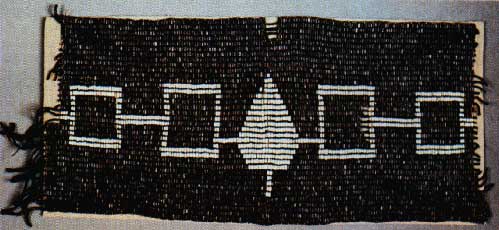
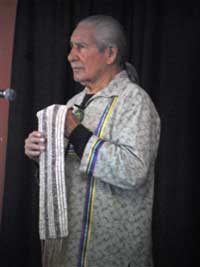 “There’s a history here, to remind our people of an agreement. But when a Papal Bull was issued declaring these are not Christian nations and all these lands are open and that an Indian is not a Christian and has no right to own land; that was the idea for land-taking. Almost 400 ratified treaties and agreements have been made and violated.
“There’s a history here, to remind our people of an agreement. But when a Papal Bull was issued declaring these are not Christian nations and all these lands are open and that an Indian is not a Christian and has no right to own land; that was the idea for land-taking. Almost 400 ratified treaties and agreements have been made and violated.
Laws were created to justify the pillaging of our lands. We were stripped of our resources, religions and dignity. When the Basic Call to Consciousness was declared in Geneva against the Doctrine of Discovery a new record was brought forth. In 1992 I spoke at the UN and we all worked for a declaration for the rights of indigenous peoples everywhere. What is the moral question? We all have to work together because it’s about reality. Time is short. The ice is melting. It’s a spiritual battle about the quality of life. Educate yourself and support leaders who speak out. Work to understand where we’ve come from.”
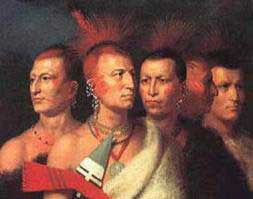 I found Oren’s words extremely moving, and they touched my heart in many deep ways.
I found Oren’s words extremely moving, and they touched my heart in many deep ways.
As I began to explore more about the Great Law of Peace, I learned how much the Great Law of Peace created by the Iroquois and the Iroquois Constitution influenced our U.S. Constitution, which was first framed in 1787 and then adopted in 1789.
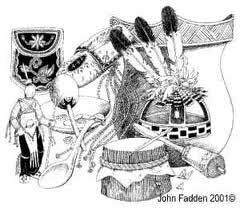 In the 1750’s, Benjamin Franklin first became familiar with the Iroquois political system and developed a deep interest in Indians. He was appointed the first Indian commissioner for the Pennsylvania colony, and recognized the lasting value found in the Iroquois Constitution. Thomas Jefferson also acknowledged that he preferred the American Indian concept of liberty over the European monarchy system. Because of their deep appreciation of many of the core concepts in the Iroquois Constitution, they eventually ended up in our Constitution. On September 16, 1987, the U.S. Senate passed a resolution officially stating that the U.S. Constitution was modeled after the Iroquois Constitution, the Great Law of Peace.
In the 1750’s, Benjamin Franklin first became familiar with the Iroquois political system and developed a deep interest in Indians. He was appointed the first Indian commissioner for the Pennsylvania colony, and recognized the lasting value found in the Iroquois Constitution. Thomas Jefferson also acknowledged that he preferred the American Indian concept of liberty over the European monarchy system. Because of their deep appreciation of many of the core concepts in the Iroquois Constitution, they eventually ended up in our Constitution. On September 16, 1987, the U.S. Senate passed a resolution officially stating that the U.S. Constitution was modeled after the Iroquois Constitution, the Great Law of Peace.
On the morning of the third day, Tom again welcomed us and began to share more of his thoughts and experiences.
“I’m a Bear Clan person. We walk a tightrope sometimes. We want all the world to regain their humor – that’s the basis of life. We need to nourish our children and each other. When I was a teenager, my grandfather told me, “Our grandchildren will go back to where we once lived, meaning the Mohawk Valley.”
“At that time we lived at our “hunting grounds” in Canada. Our world was small in ’93. I had relatives who tried to settle here in the 50’s but they failed. The farmers took them to court. The Indians had no lawyer and were unprepared. They went home. I wanted to come here. They told me “Oh you want to run away.” There was a lot of discouragement. There were civil wars, we barely survived. Tribes came to help us. Finally I gave up. I had a home and land. Then there was another civil war. I was sucked in; it seemed like there was no home. We’ll start all over to rebuild our nation.”
“Not me,” I told them. I saw medicine woman; she was a seer. I asked her if it was time to return. She said “It’s right. That is our home but it will be most difficult.” There were many meetings. She told me I could only do it with seven families who are committed.
When we got here, by a miracle, a family bought this property and gave it to us. That was 18 years ago. I asked my wife, Alice, to join me. For a nation to be born again. She joined me, and she’s standing right next to me the whole way. We came here to rebuild our nation again. So we can be human again. Let us not waste a moment.”
He also shared with us his journey to come to terms with his personal and challenging relationship with his mother which was immensely moving for everyone present, opening our hearts and souls to a deeper compassion.
When I had the opportunity of talking with Tom Porter I asked him: “What continues to be the most urgent reasons you do the work you do?”
“I thought that the Indian nations in America were colonized, almost extinct.” He replied. “Europe took our resources and left us spirit-less left us, without hope, without any resistance to fight. I thought, “What do we do about it?” You can only cry so much then you have to do something; you can’t have self-pity. I began to think of ways how to stand back up and so I thought the first thing we have to know is who we are. What was it the creator gave to us? What was supposed to be? I began to wonder that, even as a kid. So I would listen to old people and I found that they had lots of mistrust for the European people but they were also very submissive. They didn’t want to answer back even though they knew it was wrong. They knew it was wrong but they tried to live with it. I started to listen, here and there, to bring the knowledges back. They were like a 10,000 piece puzzle, shattered all over.”
“I began to do it. It wanted to live. It didn’t want to die. It made me feel good. It still has power so I say that my family needs to have our extended family all across the country. We all need to have it. From the Choctaw, the Chippewa, the Shoshone, the Lakota, everybody across the country; I began to include all of them. I don’t want to be in a group that sits idly by and does nothing. That’s empty, shallow, not really a life.
I asked: “Are you seeing progress in New York State and across the country?””
I do,” he replied, “I do see lots of hope, lots of light and life all over the place. It’s hard to miss it. I meet people that think that way almost every day. I know thousands are like zombies and its really scary. And there is also a war out there making people choose sides that say, “Our way is the right way and if you don’t believe in what we do, you’re not one of us.” That’s scary. And if you’re not one of them, they condemn you. No spirit should advocate war. If you don’t conform you get eliminated. That’s a deep terrorism that goes on today. I thought this was civilization. These are the basic things I don’t want to be a part of. So I work to rebuild our nation. It’s so important to say hello to each other and help to make each other feel vibrant and grow fast and healthy and strong and then life will be worthy.”
“We need to glorify each other, appreciate each other. The diversity, the contrast is beautiful. One of our elders said: “If all the flowers were red roses, we’d die of boredom and lonesome-ness. The Creator made every flower a different color and fragrance. Beauty is everywhere.”
“I see young people everywhere dedicating themselves to our customs. They’re doing what the old people did well and as natural as they can. They have taken the time to do these things. They are beginning to know. I see a lot of it – it’s actually happening. It gives me hope. I’m not afraid to get old and die. I’m happy that they want to make it happen.”
I also had the privilege of talking with Johnny Arlee, cultural leader and Elder of the Confederated Salish and Kootenai Tribes. I asked how he began to know his roots.
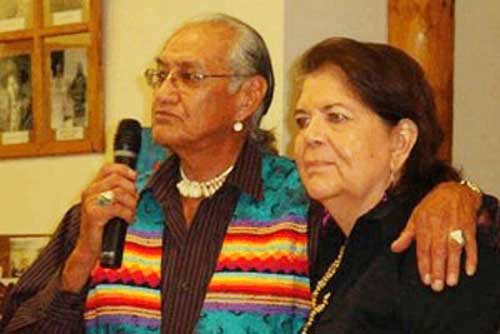
Johnny Arlee and Wilma Mankiller
“My great grandfather organized dance groups so I traveled with them, performing in pageants. It was my first experience being in front of an audience. In 1934 the Government took away our Chiefs and replaced them with councils which took over. In those days the Chief could tell you how to take care of your children, how to pray, how to gather roots, berries. They told us who we were. My great grandfather told me about the chiefs. He was selected as a chief because he had a caring ear. He listened to people. The councils that took over were run by political/business people so we lost a shepherd to correct us. We became a lost people. I used to live the life of a tramp, hopping freight trains, right after I was in the army. I’d come into a new town, it was like coming into a jungle. I’d be asked immediately: “What do you have to put in the pot?” Everyone always had to give something to the pot. Everyone everywhere’s got a rule to go by. It was a crazy life so I went back home to Montana. I found a way back in, to make a difference. I have nine grandchildren now and I try and keep in contact with them, but it’s very difficult. My job is bringing back culture. I do what I do because when you do it with your heart, it comes back to you. Today we have to take the time to see the flowers, to listen to one another. We’re all beautiful.”
All of the unique experiences I had, learning about the Mohawk Tribe and the Iroquois People, getting to know chiefs, elders and clan mothers brought me a deep understanding that I was totally unaware of. Learning their stories, hearing their words touched my soul in a very deep way, illuminating even further how richly connected we all are to the roots of our Invisible Circle. It remains our responsibility to experience and learn more of everyone’s traditions and cultures, to develop a greater respect and understanding. It’s the only way we can truly become One Family on the planet earth.
(For more info: visit: www.iroquoismusem.org, click on “Learning Longhouse.” Visit www.mohawkcommunity.com, visit: the American Indian Institute, P.O. Box 1388, Bozeman, MT 59771-1388, 877-587-6001, www.TwoCircles.org, visit: http://www.cskt.org/tr/fire_firehistoryproject.htm. Suggested reading from Eric Noyes, Executive Director, American Indian Institute: the book, Basic Call to Consciousness, edited by Akwesasne Notes. The book is available from the publisher, $12.95 (http://www.bookpubco.com/products/basic-call-consciousness) or at Amazon and contains the papers from 1977 and introductory chapters on the Haudenosaunee and the Great Law of Peace.”). Mr. Noyes wrote: “In 1977 twenty-one of the most respected traditional American Indian leaders journeyed to Geneva, Switzerland to deliver to NGOs of the United Nations the Iroquois Address to the Western World. The papers presented conveyed the point of view of the grassroots Indigenous people of the planet: “Human beings are abusing one another, the planet they live on, and their own individual persons. The destruction of the natural world and its people is the clearest indicator of mankind’s spiritual poverty.” Together the papers are a basic call to consciousness of the sacred web of life in the Universe. It is a powerful call that has ancient roots but very forward looking, even futuristic, implications. In the new edition John Mohawk introduces the events that transpired prior to the trip to UN, Chief Oren Lyons gives an overview on the struggle for self-determination before and since the Geneva meetings, and an afterword by Jose Barreiro looks to a new era of possibility for Native nations.) •























